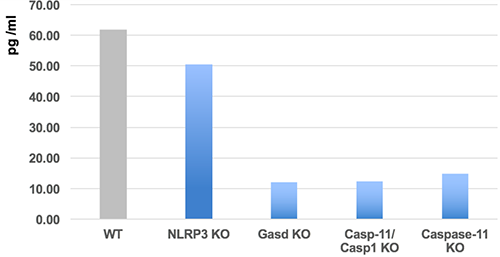Gasdermin D (mouse) ELISA Kit
| Code | Size | Price |
|---|
| AG-45B-0011-KI01 | 96 wells | £540.00 |
Quantity:
Prices exclude any Taxes / VAT
Overview
Regulatory Status: RUO
Target Species: Mouse
Shipping:
Blue Ice
Storage:
+4°C
Images
Documents
Further Information
Alternate Names/Synonyms:
Gasdermin Domain-containing Protein 1; Gasdermin-D (C-terminal); GSDMD-CT; Gsdmd
Assay Type:
Sandwich
Detection Type:
Colorimetric
EClass:
32160000
Handling Advice:
After standard reconstitution, prepare aliquots and store at -20°C.Avoid freeze/thaw cycles.Plate and reagents should reach room temperature before use.
Long Description:
ELISA assay. Detects full-length and cleaved mouse Gasdermin D (C-terminus) in cell culture supernatants and cell extracts. Does not cross-react with human gasdermin D. Colorimetric sandwich assay. Sample Type: Cell Culture Supernatant, Cell Lysate. Range: 15.6 to 1000pg/ml. Sensitivity: 14pg/ml. Inflammasomes are multimeric protein complexes that comprise a sensor (e.g. NLRP3), an adaptor (ASC/Pycard) and the procaspase-1. An inflammasome assembles in response to a diverse range of pathogen-associated or danger-associated molecular patterns (PAMPs or DAMPs). The inflammasome platform leads to activation of caspase-1, which further induces maturation of interleukin-1beta and -18 (IL-1beta and IL-18) through proteolytic cleavage of pro-IL-1beta and pro-IL-18. Activated caspase-1, and also the recently characterized caspase-11 non-canonical inflammasome pathway, also cleave the intracellular gasdermin D, which leads to a particular form of inflammatory cell death called pyroptosis. The gasdermin family members contain N-terminal domains that are capable of forming membrane pores to induce cytolysis, whereas the C-terminal domains of gasdermins function as inhibitors of such cytolysis through intramolecular domain association. Caspase-1 or -11 cleavage of gasdermin D is required for regulation of pyroptosis: upon protease cleavage of the gasdermin N- and C-domain linker, the disruption of the intramolecular domain interaction in the presence of lipids releases the N-domain to assemble oligomeric membrane pores that trigger cell death. Gasdermin D seems to be a key effector in the LPS-induced lethal sepsis.
NCBI, Uniprot Number:
Q9D8T2
Package Type:
Box
Product Description:
Inflammasomes are multimeric protein complexes that comprise a sensor (e.g. NLRP3), an adaptor (ASC/Pycard) and the procaspase-1. An inflammasome assembles in response to a diverse range of pathogen-associated or danger-associated molecular patterns (PAMPs or DAMPs). The inflammasome platform leads to activation of caspase-1, which further induces maturation of interleukin-1beta and -18 (IL-1beta and IL-18) through proteolytic cleavage of pro-IL-1beta and pro-IL-18. Activated caspase-1, and also the recently characterized caspase-11 non-canonical inflammasome pathway, also cleave the intracellular gasdermin D, which leads to a particular form of inflammatory cell death called pyroptosis. The gasdermin family members contain N-terminal domains that are capable of forming membrane pores to induce cytolysis, whereas the C-terminal domains of gasdermins function as inhibitors of such cytolysis through intramolecular domain association. Caspase-1 or -11 cleavage of gasdermin D is required for regulation of pyroptosis: upon protease cleavage of the gasdermin N- and C-domain linker, the disruption of the intramolecular domain interaction in the presence of lipids releases the N-domain to assemble oligomeric membrane pores that trigger cell death. Gasdermin D seems to be a key effector in the LPS-induced lethal sepsis.
Range:
15.6 to 1000pg/ml
Sample Type:
Cell Culture Supernatant, Cell Lysate, Serum
Sensitivity:
14pg/ml
Specificity:
Detects full-length and cleaved mouse Gasdermin D (C-terminus) in cell culture supernatants and cell extracts. Does not cross-react with human or rat gasdermin D.
Transportation:
Non-hazardous
UNSPSC Category:
ELISA Kits
UNSPSC Number:
41116126
Use & Stability:
12 months after the day of manufacturing. See expiry date on ELISA Kit box.
References
Dynamin-related protein 1 deficiency accelerates lipopolysaccharide-induced acute liver injury and inflammation in mice: L. Wang, et al.; Nature Commun. Biol. 4, 894 (2021) [Samples: Serum, Cell Lysates]



